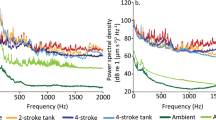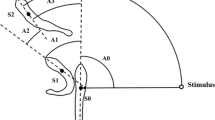Abstract
The swimming angle of larval Japanese anchovy (Engraulis japonicus) was measured in a tank, and target strength (TS) was calculated using a theoretical scattering model. The mean swimming angle was 12.8° (SD ±22.1). Increased speeds of flow led to increased mean swimming angles. The mean swimming angle at flow of 5 cm s−1 was higher than at other speeds. TS values were estimated using a distorted-wave Born approximation model for two cases. Average values were 1–3 cm s−1 (11.5° ± 22.1) and 5 cm s−1 (16.6° ± 21.7) for cases 1 and 2, respectively. For case 1, TS ranged from −92.0 to −74.7 dB with a mean of −79.4 dB at 120 kHz. For case 2, TS ranged from −92.2 to −75.2 dB with a mean of −79.9 dB. The mean TS in case 2 was lower than that in case 1, with the maximum difference being 1.0 dB at 120 kHz (standard length 22.0 mm). However, there were no significant differences between the regression lines of cases 1 and 2. Thus, changes in flow speed altered the swimming angle of larval Japanese anchovy, but had little influence on TS.






Similar content being viewed by others
References
Annual Statistics on Fishery and Aquaculture Production 2006 (2008) Statistics Department, Ministry of Agriculture, Forestry and Fisheries, Tokyo
Saiura K, Takeda Y (2001) Spring fishing ground formation of anchovy, Engraulis japonica, larvae in 1999 and 2000 in the Kii Channel (in Japanese). Fish Biol Oceanogr Kuroshio 2:109–118
Morioka S (2006) Trial of spring shirasu (Engraulis japonicus larvae) fishery forecast in Kii Channel by using multiple regression analysis (in Japanese). Fish Biol Oceanogr Kuroshio 7:21–27
Mitani I (1988) The biological studies on the larvae of Japanese anchovy, Engraulis japonica Hottuyn, in Sagami Bay (in Japanese). PhD thesis, University of Hokkaido, Hokkaido
Honda S (2004) Abundance estimation of the young cohorts of the Japanese Pacific population of walleye pollock (Theragra chalcogramma) by acoustic surveys (In Japanese). PhD thesis, University of Hokkaido, Hokkaido
Yasuma H (2004) Studies on the acoustical biomass estimation of myctophid fishes (in Japanese). PhD thesis, University of Tokyo, Tokyo
Zhao X, Wang Y, Dai F (2008) Depth-dependent target strength of anchovy (Engraulis japonicus) measured in situ. ICES J Mar Sci 65:882–888
Foote KG, Traynor JJ (1988) Comparison of walleye pollock target-strength estimates determined from in situ measurements and calculations based on swimbladder form. J Acoust Soc Am 83(1):9–17
Simmonds J, MacKennan D (2005) Fisheries acoustics, 2nd edn. Blackwell, Oxford
Uotani I (1973) Diurnal changes of gas bladder and behavior of postlarval anchovy and other related species (in Japanese with English abstract). Bull Jpn Soc Sci Fish 39:867–876
Miyashita K (2003) Diurnal changes in the acoustic-frequency characteristics of Japanese anchovy (Engraulis japonicus) post-larvae “shirasu” inferred from theoretical scattering models. ICES J Mar Sci 60:532–537
Stanton TK, Chu D, Wiebe PH (1993) Sound scattering by several zooplankton groups. II. Scattering models. J Acoust Soc Am 103:236–253
Chu D, Foote KG, Stanton TK (1993) Further analysis of target strength measurements of Antarctic krill at 38 and 120 kHz: comparison with deformed cylinder model and inference of orientation. J Acoust Soc Am 93:2985–2988
McGehee DE, O’Driscoll RL, Martin Traykovdky LV (1998) Effects of orientation on acoustic scattering from Antarctic krill at 120 kHz. Deep-Sea Res 45:1273–1394
Foote KG (1980) Averaging of fish target strength functions. J Acoust Soc Am 67(2):504–515
Foote KG (1990) Speed of sound in Euphausia superba. J Acoust Soc Am 87:1405–1408
Greenlaw CF (1977) Backscattering spectra of preserved zooplankton. J Acoust Soc Am 62:44–52
Foote KG (1979) On representing the length dependence of acoustic target strengths of fish. J Fish Res Board Can 36(12):1490–1496
Hunter JR (1972) Swimming and feeding behavior of larval anchovy, Engrauis mordax. Fish Bull 70:821–838
Batty RS (1984) Development of swimming movements and musculature of larval herring (Clupea harengus). J Exp Biol 110:217–229
Blaxter JHS, Staines ME (1971) Food searching potential in marine fish larvae. Fourth European marine biological symposium. Cambridge University Press, Cambridge
Mikami H, Mukai T, Iida K (2000) Measurements of density and sound speed contrasts for estimating krill target strength using theoretical scattering models (in Japanese with English abstract). Nippon Suisan Gakkaishi 66(4):682–689
Matsukura R, Yasuma H, Murase H, Yonezak S, Funamoto T, Honda S, Miyashita K (2009) Measurement of density contrast and sound-speed contrast for target strength estimation of Neocalanus copepods (Neocalanus cristatus and Neocalanus plumchrus) in the North Pacific Ocean. Fish Sci 75:1377–1387
Acknowledgments
We thank the captains and crew of Kanagasaki Maru No. 8 for their cooperation in collecting specimens. We also thank Yukio Ueta, Keisuke Mori Fisheries Research Institute, Tokushima Agriculture and the Forestry and Fisheries Technology Support Center for their support in collecting specimens. This study was supported in part by the Fisheries Agency of Japan under the project “Research and Development Projects for Application in Promoting New Policy of Agriculture Forestry and Fisheries.” We thank this institution for their support.
Author information
Authors and Affiliations
Corresponding author
Rights and permissions
About this article
Cite this article
Ito, Y., Yasuma, H., Masuda, R. et al. Swimming angle and target strength of larval Japanese anchovy (Engraulis japonicus). Fish Sci 77, 161–167 (2011). https://doi.org/10.1007/s12562-011-0323-1
Received:
Accepted:
Published:
Issue Date:
DOI: https://doi.org/10.1007/s12562-011-0323-1




